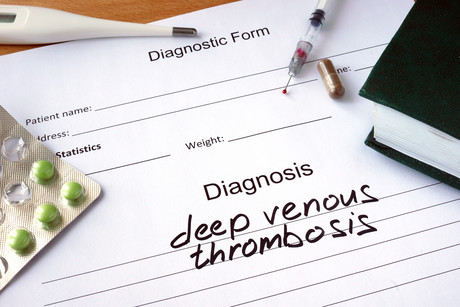New standard tackles venous thromboembolism deaths

Most people will have heard of ‘economy class syndrome’ — a catchy term for the potentially fatal threat of venous thromboembolism (VTE) on long-haul flights. However, most are unaware that while their risk in the air is only four times their normal risk, it increases to 100 times greater than normal once admitted to hospital.
Each year in Australia, 30,000 people will develop VTE.1, 2 More than 5000 people will die as result — and more than half of these cases occur within 90 days of hospitalisation, with both medical and surgical patients affected.3 Many clinicians remain unaware that this elevated risk extends for more than three months following their patient’s hospitalisation.
VTE causes at least 7% of all hospital deaths,4,5 and is considered to be one of the leading preventable causes of death in hospital. In up to one-quarter of cases, sudden death may be the first clinical sign of VTE.3,6
Accordingly, the Australian Commission on Safety and Quality in Health Care has developed a nationally agreed standard of care to address this very significant health threat.
The Venous Thromboembolism Prevention Clinical Care Standard is informed by leading clinical experts, and translates international guidelines and other current evidence into clinical practice to reduce avoidable death or disability caused by hospital-acquired VTE.
Prevention is key to avoiding VTE
An individual’s risk of VTE is complex and linked to multiple factors, including their genetic predisposition, their past history of blood clots, their current medical issues, the medications they are taking, the procedure they are undergoing and their mobility status.
Encouragingly, we know that whatever their underlying individual circumstances, implementing good risk prevention strategies can decrease hospital-acquired VTE by up to 70%.
Given the effectiveness of these prevention strategies, it is worrying that a recent Australian report7 found that fewer than half of clinical units surveyed were routinely assessing patients for their risk of developing blood clots on admission to hospital. Furthermore, only 74% of those assessed to be at risk were offered VTE prevention based on the risk of their risk assessment.
It is vital that hospitals have processes in place to routinely assess a patient’s risk of VTE and, where appropriate, provide them with an effective individualised VTE prevention plan during and following their hospital stay.
A systematic approach to preventing VTE
Clinical care standards identify quality statements about the care that should be delivered, and provide supporting information for health service organisations, clinicians and consumers.
The Venous Thromboembolism Prevention Clinical Care Standard will assist health service organisations to ensure that they have systems in place to routinely:
- assess each patient’s risk of clotting;
- balance that against the risk of bleeding from prevention techniques;
- discuss those risks with the patient;
- develop a management plan that is appropriate for that individual; and
- ensure that, where appropriate, the management plan is handed over to support ongoing prevention efforts and monitoring of side effects in the community.
Minimising harm from anticoagulants
A significant medication safety issue that has been highlighted through incident monitoring is the inappropriate duplication of anticoagulants. A common example is when a clinician does not recognise that a patient is already taking an oral anticoagulant for another indication (eg, artificial heart valve, atrial fibrillation) and initiates injectable VTE prevention (eg, Clexane), causing excessive anticoagulation and bleeding.
The clinical care standard is accompanied by two appendices which function as ready references for clinicians to support both the recognition of anticoagulants and the safe use of anticoagulants.
Find out more
Download and review the Venous Thromboembolism Prevention Clinical Care Standard and the supporting resources at the Commission’s website: www.safetyandquality.gov.au/VTE.
References
- Ho WK, Hankey GJ, Eikelboom JW. The incidence of venous thromboembolism: a prospective, community-based study in Perth, Western Australia. Med J Aust. 2008;189(3):144-7.
- Szabo F, Marshall C, Huynh DK. Venous thromboembolism in tropical Australia and in Indigenous Australians. Semin Thromb Hemost. 2014;40(7):736-40. Epub 2014/10/04.
- Heit JA, Spencer FA, White RH. The epidemiology of venous thromboembolism. J Thromb Thrombolysis. 2016;41:3-14.
- Jha AK, Larizgoitia I, Audera-Lopez C, Prasopa-Plaizier N, Waters H, Bates DW. The global burden of unsafe medical care: analytic modelling of observational studies. BMJ Quality Safety. 2013;22(10):809.
- Wendelboe AM, McCumber M, Hylek EM, Buller H, Weitz JI, Raskob G. Global public awareness of venous thromboembolism. J Thromb Haemost. 2015;13(8):1365-71.
- Cohen AT, Agnelli G, Anderson FA, Arcelus JI, Bergqvist D, Brecht JG, et al. Incidence of Venous Thromboembolism (VTE) in Europe. The number of VTE events and associated mortality. J Thromb Haemost. 2007;98(4):756-64.
- Clinical Excellence Commission. Safer systems better care – Quality Systems Assessment statewide report 2013. Sydney: Clinical Excellence Commission; 2014; Available from: http://www.cec.health.nsw.gov.au/__data/assets/pdf_file/0007/258685/hs14-020-cec-qsa-report-dv3.pdf
Some patients wait 6 years to see a public hospital specialist. Here's how to fix this
Australian research spanning more than a decade suggests there are ways to reduce waiting lists...
Reusing medical equipment is good for the planet. But is it safe?
A new study tested replacing just one kind of item — single-use absorbent pads, known...
Stewardship and sustainability: environmentally minded medical products
Australia's health sector produces twice as much carbon emissions as aviation. But with...




![[New Zealand] Transform from Security Awareness to a Security Culture: A Vital Shift for SMB Healthcare — Webinar](https://d1v1e13ebw3o15.cloudfront.net/data/89856/wfmedia_thumb/..jpg)
![[Australia] Transform from Security Awareness to a Security Culture: A Vital Shift for SMB Healthcare — Webinar](https://d1v1e13ebw3o15.cloudfront.net/data/89855/wfmedia_thumb/..jpg)




